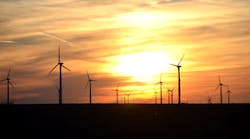On Tuesday, March 29, wind turbines in the Lower 48 states produced 2,017 GWh of electricity, making wind the second-largest source of electric generation for the day, only behind natural gas, according to the U.S. Department of Energy’s Energy Information Administration.
In the meantime, nuclear power is making up less of the U.S. power generation mix as more plants retire.
Daily wind-powered electricity had surpassed coal-fired and nuclear electricity generation separately on other days earlier this year but had not surpassed both sources on a single day, according to the EIA’s Hourly Electric Grid Monitor.
Consistent growth in the installed capacity of wind turbines in the United States has led to more wind-powered electricity generation. In September 2019, U.S. wind capacity surpassed nuclear capacity, but wind still generated less electricity than nuclear because of differences in those technologies’ use.
The average capacity factor of U.S. wind generators (35% in 2021) is lower than the average capacity factor of nuclear generators (93% in 2021), which are designed to run at or near full output, which they typically do. Wind turbines currently rank as the third-largest source of generating capacity in the United States, behind natural gas-fired generators and coal-fired generators.
In the U.S., wind speeds, and correspondingly, wind-powered electricity generation, often peak during spring. On March 29, the Southwest Power Pool (SPP), which covers parts of Oklahoma, Kansas, Nebraska, North Dakota, South Dakota and neighboring states, and the Electric Reliability Council of Texas (ERCOT) both reported new wind power records.
In 2021, for the second consecutive year, U.S. nuclear electricity generation declined. Output from U.S. nuclear power plants totaled 778 million MWh in 2021, or 1.5% less than the previous year. Nuclear energy’s share of U.S. electricity generation across all sectors in 2021 was similar to its average share in the previous decade: 19%.
Six nuclear generating units with a total capacity of 4,736 MW have retired since the end of 2017. Three more reactors with a combined 3,009 MW of capacity are scheduled to retire in the coming years: Michigan’s Palisades is scheduled to retire later this year, and California’s Diablo Canyon is slated to retire one generating unit in 2024 and one in 2025.
The loss of electricity generation from the retirement of Indian Point Unit 3 in 2021 was partially offset by an increase in the generation of the remaining nuclear fleet at a higher capacity factor. Capacity factors measure how much of the time units operate, and nuclear units tend to be run more of the time than almost all other electricity-generating technologies. The U.S. nuclear power fleet has achieved an average annual capacity factor of at least 90% in every year since 2012. The nuclear capacity factor averaged 93% in 2021.
Because electricity demand tends to be lowest in the spring and fall months, some generators—including both nuclear and coal—reduce their output or scheduled maintenance during these months. Also, on days when weather patterns lead to more wind generation, competing coal-fired and natural gas-fired generators often are called upon to reduce their output so that overall electricity supply matches demand.
The natural variation of wind speeds contributes to very different amounts of wind generation, depending on the time of day or season. Wind first ranked as the second-largest source of U.S. electricity generation for an hour in late March 2021.
On a monthly basis, there has been less wind generation in the United States than natural gas-fired generation, coal-fired generation, or nuclear generation. The EIA does not expect wind to surpass either coal-fired or nuclear generation for any month in 2022 or 2023.
Although output has been rising from renewable energy sources and from turbine plants using natural gas, the U.S. nuclear fleet continues to operate at high and consistent utilization rates. Financial pressures from competitive wholesale power markets remain the primary cause of nuclear power plant retirements. Four units at two sites in Illinois had announced their intention to retire but then reversed that decision after the Illinois state legislature provided financial incentives to support the nuclear units' continued operation.
The Bipartisan Infrastructure Law, which was enacted in November 2021, includes the allocation of $6 billion to prevent the premature retirement of existing nuclear power plants. The funding will be made available to nuclear power plants that might otherwise retire and that are certified by the Nuclear Regulatory Commission as safe to continue operations.
Two nuclear generating units now under construction in Georgia (Vogtle Units 3 and 4) plan to come online by the end of 2023. Each unit is rated at 1,114 MW, and they will be the first nuclear units to come online in the United States since Tennessee's Watts Bar Unit 2 came online in mid-2016.


